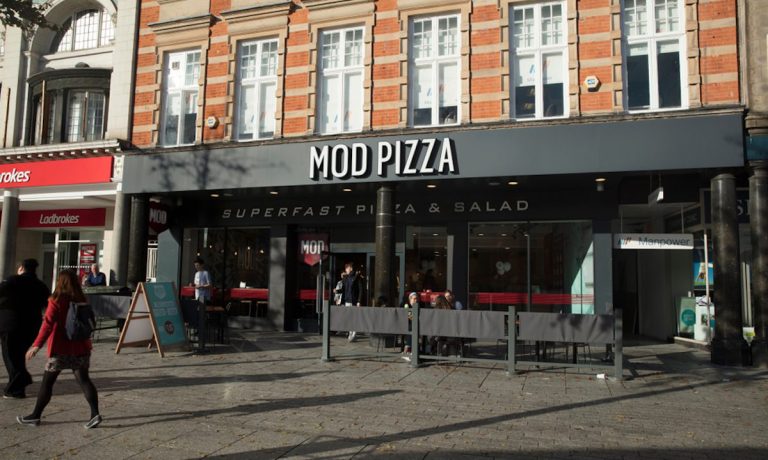
Pizza chains, which typically relied heavily on off-premise sales even before quarantine, have been at the forefront of the restaurant industry’s digital shift. Now, Seattle-based fast-casual chain MOD Pizza, which has hundreds of locations across 29 states, is looking to parlay the learnings of the last couple of years into success on the public market.
You may also like: To See Where the QSR Industry Is Headed, Look to Pizza
On Tuesday (Nov. 23), the brand announced that it has submitted a draft filing with the U.S. Securities and Exchange Commission (SEC) for a proposed initial public offering (IPO). Earlier in 2021, the chain opened its 500th store, and in October, MOD announced its new iOS app in partnership with the digital ordering platform Koala.
“Back in the day, our app used to be a standalone application. If you were a user of the app, and then you went to our website or our mobile website, you’d be like, ‘Huh, this is a little bit different,’” Kevin Flaherty, vice president of digital marketing at MOD Pizza, told PYMNTS in an interview. “Over time, we’ve been trying to create a really seamless experience, where everything from sign-on to how you add things to the cart to how you check out is the same … that’s probably the biggest change that customers have seen as we’ve evolved our digital strategy.”
Brands’ digital presences are more important than ever, given the risk of losing their highest-value customers to third-party aggregators, which take a significant portion of the sale and stand in the way of restaurants and their diner data. In fact, PYMNTS’ research from the new report, Digital Divide: Aggregators and High-Value Restaurant Customers, created in collaboration with Paytronix, finds that restaurants’ highest-spending, highest-frequency customers are 60%-170% more likely than other customers to order online through third-party aggregators.
Related news: Restaurants Fight Back Against Aggregators With Promotions and Loyalty Programs
Finding the UX Balance
Flaherty believes that when it comes to consumers’ digital experiences, simplicity is key. As he put it: “I think the biggest thing that I’ve seen restaurants today get wrong is that they try to infuse too much unique experience into [mobile ordering].”
He added that for consumers, unnecessary messaging and promotions can stand in the way of doing what they came to the app to do — place and pay for their order.
Conversely, however, he recalled that MOD has in the past made the mistake of doing the opposite, eliminating too much content. He explained that when the app first launched without pictures of the menu items, the lack of images detracted from users’ ordering experience.
“One of the big learning curves was that sometimes you could go too far on the spectrum of shoppability or frictionless transactions if you take away something consumers really, really want, which is still beautiful food photography.”
Fine-Tuning the Digital Order
Looking ahead, Flaherty is interested in improving digital ordering with conversational artificial intelligence (AI) and improving the handoff experience. As to the former, MOD is looking into automated order-taking via phone call, removing the human labor from the process, as well as allowing consumers to order through voice assistants from their smart devices.
Of course, the customer’s experience does not end after the order is placed.
“As much as we’ve worked on ordering channels, where our business is really pivoting is in making sure we’re optimizing the handoff methods,” Flaherty said. “You’re seeing a lot of innovation around curbside pickup, drive-thru lanes, pickup lanes — these handoff methods are becoming as important as the ordering channels that we were originally so focused on.”
These initiatives are especially relevant given the importance of speed and convenience to today’s restaurant customers. Findings from the Digital Divide report indicate that restaurants’ highest-spending, highest-frequency consumers were most motivated to order from aggregators because of the ease and convenience of the channel — while on the flip side, the most important reason they order from restaurants’ direct channels is that they believe it will save time.
Leveraging Consumer Data, Inside and Out
Also in the near future, MOD plans to improve its use of data — both in terms of its marketing capabilities to personalize messaging and digital interfaces for consumers, and in the way information is shared internally.
“If our marketing is effective, we can really blow the doors off a restaurant, because consumers are so reactive to what we’re doing digitally, whereas back in the day, that wasn’t the case,” Flaherty said.
He added that the company is excited about the possibilities posed by restaurant technology company Olo’s product Expo, which helps the restaurant provide information about consumers’ digital ordering behaviors to employees within a given store. This effort is part of MOD’s overall push to unify the brand’s digital and physical presence across channels, offering consistency and convenience.
“The brands that are going to win in this space are the ones that make sure they have delivered a seamless experience for their guests across any digital channel,” said Flaherty. “It has to be frictionless. It has to allow them to do what they want to do as quickly as possible … those brands that get that entire experience correct, from A to Z, are the ones that will do really well going forward.”